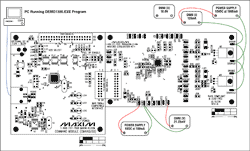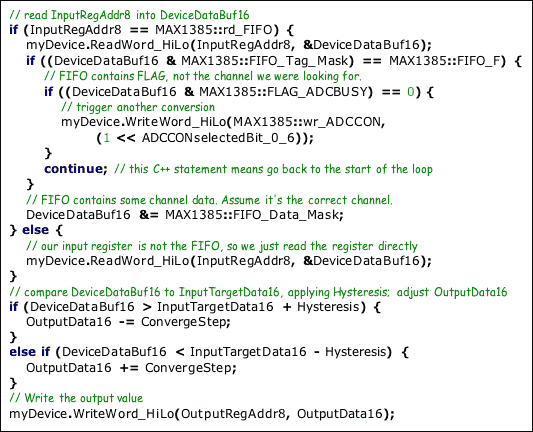
When used with the MAX1385EVKIT+ demo board, the control loop achieves a regulation accuracy of ±2%. This accuracy is limited by the gate driver output step size and the FET transconductance. Drain-current regulation step size is determined by the MAX1385's gate-voltage increment multiplied by the FET's effective transconductance. Because the MAX1385EVKIT uses an IRFZ44N MOSFET to close the loop for demonstration purposes, the regulation may not be the same as it would be when used with an LDMOS FET.
Required Hardware
- Maxim MAX1385EVKIT+
- Maxim CMAXQUSB+ (includes USB A-B cable)
- Windows 2000/XP PC with USB port
- 5VDC at 100mA power supply
- 10VDC at 1000mA power supply
- DMM for measuring drain current
- DMM for measuring drain voltage
- DMM for measuring PGAOUT amplified current-sense voltage
- Optional: oscilloscope for monitoring GATE1 voltage and PGAOUT1 drain current
Assemble the hardware according to Figure 1.
- Plug the CMAXQUSB header P3 into the MAX1385EVKIT connector J1.
- Connect the MAX1385EVKIT's DRAIN1 and DRAIN2 pins to the current meter (-).
- Connect the current meter (+) to the power supply (+).
- Connect the MAX1385EVKIT's SOURCE1 and SOURCE2 pins to the power supply (-).
- Connect the voltage meter (+) to the MAX1385EVKIT's DRAIN1 pin.
- Connect the voltage meter (-) to the MAX1385EVKIT's SOURCE1 pin.
- Connect the MAX1385EVKIT's AVDD pin to the DVDD pin (or, optionally, connect to an external 5V DC supply).

More Detailed Image (PDF, 387kB)
Figure 1. MAX1385EVKIT hardware configuration.
ProcedureSet the CMAXQUSB's VDD Select jumper to the 5V position.
Connect the CMAXQUSB to the PC's USB port. If this is the first time a CMAXQUSB has been attached to the PC, the plug-and-play wizard will appear. Guide the GUI to the installed location of the device driver, in MAX1385_Appnote_src.zip\src\USB_driver.
Start the DEMO1385.EXE program. A console will appear on the screen. Enter the following series of commands at the console:
Got board banner: Maxim CMAXQUSB V01.04.32 >
Searching for MAX1385...
Found MAX1385 at 0x4e
Note: when using MAX1385EVKIT with CMAXQUSB,
connect 5V DVDD supply to AVDD.
Monitor the regulation by watching the DMM.
The voltage on PGAOUT1 regulates between 20.8mV and 21.7mV, which is a variation of 0.45mV (2%) around an average of 21.25mV.
Source Code Walk-ThroughThe source code was developed with the free dev-cpp IDE, which uses the GNU gcc-3.4.2 C++++ compiler.
Listing 1 shows a simplified version of the C++ code performed inside the regulation loop. Output statements and error handling have been removed for clarity.
Listing 1. Simplified C++ code.

Menu SystemThe complete source code implements the console menu system seen in Listing 2, which connects to the CMAXQUSB module.
Listing 2. Console menu system.
============================================================
CmodComm test program main menu when not connected
A) adjust timing parameters
L) CmodLog... functions
C) connect
D) Debug Messages
X) exit
---------------------------------------------
C
Board connected.
Got board banner: Maxim CMAXQUSB V01.04.32 >
Searching for MAX1385...
Found MAX1385 at 0x4e
Note: when using MAX1385EVKIT with CMAXQUSB,
connect 5V DVDD supply to AVDD.
============================================================
CmodComm test program main menu after successful connect
T) Test the device
8) CmodP8Bus... functions
A) adjust timing parameters
L) CmodLog... functions
P) CmodPin... functions
S) CmodSpi... functions
M) CmodSMBus... functions
$) CmodCommStringWrite list of hex codes
R) CmodBoardReset
D) Disconnect
============================================================
T Test menu
T ? Hunt for active devices
T R Read register
T W Write register
T S Servo loop
T VP Verify Power-On Register Values
T VM reg mask Verify Register Memory Persistence, All Combinations ...
T VW reg mask Verify Register Memory Persistence, Walking-One's test ...
============================================================
Write register:
T W AD Write ADCCON
T W AH Write ALMHCFG
T W AS Write ALMSCFG
T W FI1 Write FINE1
T W FI2 Write FINE2
T W FC1 Write FINECAL1
T W FC2 Write FINECAL2
T W FCT1 Write FINECALTHRU1
T W FCT2 Write FINECALTHRU2
T W FT1 Write FINETHRU1
T W FT2 Write FINETHRU2
T W HC Write HCFG
T W HT1 Write THRUHI1
T W HT2 Write THRUHI2
T W HW1 Write HIWIPE1
T W HW2 Write HIWIPE2
T W IH1 Write IH1
T W IH2 Write IH2
T W IL1 Write IL1
T W IL2 Write IL2
T W LD Write LDAC
T W LT1 Write THRULO1
T W LT2 Write THRULO2
T W LW1 Write LOWIPE1
T W LW2 Write LOWIPE2
T W P Write PGACAL
T W SC Write SCLR
T W SS Write SSHUT
T W TH1 Write TH1
T W TH2 Write TH2
T W TL1 Write TL1
T W TL2 Write TL2
T W X /hexRegAddr/ Write any register by its hexadecimal address
============================================================
Read register:
T R AH Read ALMHCFG
T R AS Read ALMSCFG
T R FF Read FIFO
T R FI1 Read FINE1
T R FI2 Read FINE2
T R FL Read FLAG
T R HC Read HCFG
T R HW1 Read HIWIPE1
T R HW2 Read HIWIPE2
T R IH1 Read IH1
T R IH2 Read IH2
T R IL1 Read IL1
T R IL2 Read IL2
T R LW1 Read LOWIPE1
T R LW2 Read LOWIPE2
T R TH1 Read TH1
T R TH2 Read TH2
T R TL1 Read TL1
T R TL2 Read TL2
T R X /hexRegAddr/ Read any register by its hexadecimal address
============================================================
T S Test Servo menu
T S O FCT1 0300 output register [wr_FINECALTHRU1, initial value 0x0300]
T S I FF input register [rd_FIFO]
T S A 2 ADC input channel [ bit 2 = 0x0004 = ADCCON_CURRENT_CS1 ]
T S T 0020 target value [0x0020]
T S C 1 ConvergeStep [1]
T S H 1 hysteresis [1]
T S M 60000 max_loop_duration_msec [60000]
T S R servo loop run
============================================================
Windows is a registered trademark of Microsoft Corp.
欢迎分享,转载请注明来源:内存溢出

 微信扫一扫
微信扫一扫
 支付宝扫一扫
支付宝扫一扫
评论列表(0条)